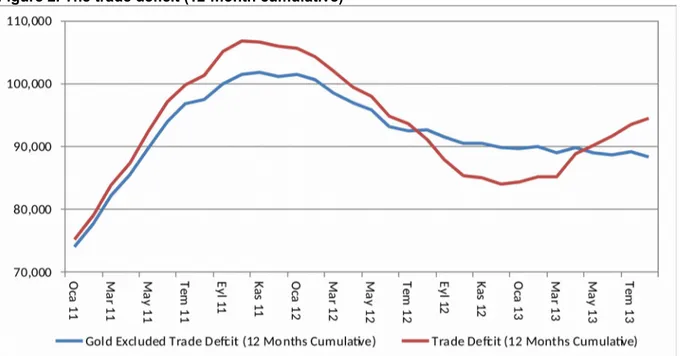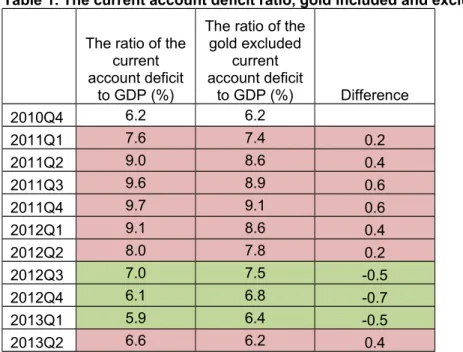GOLD-EXCLUDED CURRENT ACCOUNT DEFICIT IS DECLINING
Zümrüt İmamoglu, Barış Soybilgen** Executive Summary
Between 2011 and 2013, sharp ups and downs in gold exports and imports caused significant volatility in the current account deficit and the trade deficit. The gold-excluded current account deficit was higher than the actual in 2012 and it was lower than the actual in 2013. Moreover, it has been declining steadily since mid-2011. When gold and energy are excluded, the current account deficit has been stagnant and close to zero since the beginning of 2013. According to trade data for the first eight months, the revival in the economy in 2013 caused a limited increase in energy and gold excluded imports, and this was balanced by the increase in exports. Therefore, an increase in growth rate was achieved without causing an increase in the current account deficit. But, we must emphasize that this growth regime was below the long-term potential rate needed to prevent an increase in the unemployment rate and was more dependent on private and government consumption rather than investment and exports.
Gold excluded trade deficit is decreasing
Between 2011 and 2013, fluctuations in gold trade were on the news headlines due to their effects on the trade deficit and the current account deficit. When trade sanctions imposed on Iran caused problems for Turkey’s banks and financial institutions, payments for energy imports from Iran started to be carried out in gold. Hence, Turkey’s gold trade with Iran and later with United Arab Emirates surged. Figure 1 shows Turkey’s gold trade in total between 2006 and 2013. Gold exports, which took off at the end of 2011, increased up to $13.5 billion from $1 billion annually, by the end of 2012. (12 month cumulative). In 2013 gold exports almost halved, falling down to around $7 billion by the end of August. On the other hand, gold imports which used to fluctuate around $4 billion annually, took off by the end of 2010 and reached $13 billion by the end of August in 2013.
Turkey is not a large producer of gold in the world. Almost all of its gold exports to Iran are imported first and then re-exported. Normally, if the imports and exports were simultaneous (within the same month or year), there would not be any distortions neither in the trade deficit nor in the current account deficit. But as Figure 1 shows, this is not the case. Gold imports were significantly higher than exports in 2011, increasing the trade deficit. In 2012, gold exports were significantly higher than imports, this time decreasing the trade deficit. And in 2013, once again imports were higher than exports.
Figure 2 shows the trade deficit, gold-included and excluded, since 2011. Between January 2011 and August 2013, the trade deficit (included) fluctuated due to volatility in net gold trade while gold-excluded trade deficit has declined steadily since the autumn of 2011. Therefore, the observed increase in the trade deficit in 2013 is not due to the revival in domestic demand, but only due to gold trade. The revival in the economy in 2013 does not seem to have driven the trade deficit upward. It only caused trade deficit to decline at a slower pace than before.
Research Brief 13/156
Figure 1. The gold trade 2005-2011 (12-months cumulative)
Source: Turkstat, Betam.
Figure 2. The trade deficit (12-month cumulative)
Source: Turkstat, Betam.
The effect of the gold trade on the current account deficit
Table 1 shows the gold-excluded and included current account (CA) deficit ratios. Gold trade contributed to the CA deficit in 2011 and first half of 2012. Later on it had a lessening effect until the second quarter of 2013. What’s more, gold-excluded current account deficit has been declining continuously since the end of 2011. The only cause of the sharp jump in the CA deficit in the second quarter of 2013 was gold trade. Even though the ratio of current account deficit increased to 6.6 percent from 5.9 in the second quarter, the gold excluded current account deficit fell to 6.4 percent from 6.2 percent. The revival in the domestic demand does not seem to have affected the current account deficit, yet.
Table 1. The current account deficit ratio, gold included and excluded (2011-2013)*
The ratio of the current account deficit
to GDP (%)
The ratio of the gold excluded current account deficit to GDP (%) Difference 2010Q4 6.2 6.2 2011Q1 7.6 7.4 0.2 2011Q2 9.0 8.6 0.4 2011Q3 9.6 8.9 0.6 2011Q4 9.7 9.1 0.6 2012Q1 9.1 8.6 0.4 2012Q2 8.0 7.8 0.2 2012Q3 7.0 7.5 -0.5 2012Q4 6.1 6.8 -0.7 2013Q1 5.9 6.4 -0.5 2013Q2 6.6 6.2 0.4
Source: Turkstat, CBRT, Betam. *The ratio of 12-month cumulative current account deficit to 4 quarters cumulative.
Gold and energy excluded current account deficit is near zero
The contribution of energy to the current account deficit is important because Turkey is dependent on foreign energy. Figure 3 shows net energy imports (imports-exports) between 2006 and 2013. Energy imports, which had declined during the crisis due to fall in demand and prices, increased in line with high growth after the crisis. Following the slowdown in the economy in 2012, the increase in energy imports has stopped and became stagnant, but did not fall considerably. Therefore, the decrease in the current account deficit after 2011 was not caused by a decrease in energy imports.
As Figure 3 shows, the energy and gold excluded current account deficit surged after the crisis and declined sharply after 2011 following the slowdown in the economy. During 2013, it remained stable, near zero. The revival in the economy in the first half of the 2013 does not seem to have caused an increase in the gold and energy excluded current account deficit, either.
Figure 3. The gold and energy excluded current account deficit (12-month cumulative)
In 2013, economy grows without increasing the current account deficit
Figure 4 shows gold and energy excluded imports and exports (12-month cumulative). In the second half of 2012, the fall in imports was the main reason for the drop in the energy and gold excluded current account deficit. But not in 2013. After economy began to recover in 2013, gold and energy excluded imports began to increase. However, the current account deficit was stagnant, because exports were increasing at a similar pace. In 2013, 12-month cumulative gold and energy excluded exports increased by 3.9 percent while imports increased by 3.6 percent. Mild increase in exports balanced the import demand caused by the mild GDP growth. Therefore, the economy was able to grow without an increase in the current account deficit.1
The strong relationship between growth and imports is well known in the economic literature. This relationship is also valid for Turkey. Figure 5 shows the year on year GDP growth rate and quarter on quarter increase in 12-month cumulative imports. High growth rates cause sharp increases in import demand. The relationship is similar for gold and energy excluded imports. The growth regime that does not increase the current account deficit is a regime where imports and exports increase at similar rates. Therefore, when the increase in exports is low, policies that take financial stability into account are forced to limit the growth rate. In 2012 and 2013, Turkey’s Central Bank pursued such policies to achieve financial stability. Consequently, growth declined, the “bubble” in the current account deficit eased off, and energy and gold excluded current account deficit declined to 0-0.2 percent range. However, the current balance is still fragile and high growth rates might alleviate the deficit fast. The fact that the growth rate is constrained due to financial stability concerns and dependent on foreign demand is an obstacle against Turkey achieving its economic goals for year 2023.
Figure 4. Gold and energy excluded imports and exports (12-month cumulative)
Source: Turkstat, CBRT, Betam.
Figure 5. The growth and imports (percentage change)*
Source: Turkstat, CBRT, Betam.
*The quarter on quarter change of 12-month cumulative imports
High-quality growth without creating financial risk is hard
According to the trade data for the first eight months, the revival in the economy in 2013 caused a limited increase in energy and gold excluded imports, and this was balanced by the increase in exports. Therefore, an increase in growth was achieved without an increase in the current account. But, we must emphasize that a low quality growth regime that yielded a lower growth rate than Turkey’s potential is behind this balanced composition.
In the first half of the year, the GDP growth was 3.7 percent. Growth was mostly driven by private consumption and government expenditures. Private investment was weak. This “poor quality” and low growth is not enough to employ the labor force which keeps increasing at a strong pace and therefore is not enough to prevent increases in the unemployment rate. In fact, non-agricultural unemployment rate has been increasing in Turkey since the beginning of 2013.2
The current economic structure requires Turkey to agree to a slow growth regime in order not to create a current account risk. However, slow growth causes unemployment. On the other hand, it’s becoming harder to achieve high quality and high level growth rate in Turkey. The contribution of capital accumulation and employment to growth is declining as Turkey becomes a middle income country. Without further economic reforms that enhance productivity, Turkey’s potential growth rate may decline considerably in the future.3


